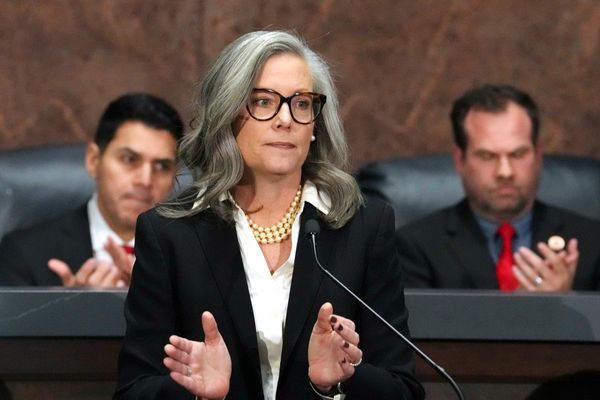
On Tuesday, a few days after the Trump administration announced its plan to slash billions of dollars in funding for biomedical and behavioral research, an investigator at a maternal health research center in Pennsylvania told Dr Meghan Lane-Fall that the cuts may lead her to leave academia altogether.
Lane-Fall urged her not to make any sudden moves. “It’s not like nothing has happened. No one’s threatened her job,” said Lane-Fall, a professor at the University of Pennsylvania. “But if she looks six months down the line, it looks uncertain.”
She did advise her colleague to update her resume.
Among the many fields of research threatened by the funding cuts is the growing effort to curb the US maternal mortality rate, which is far worse than in other rich nations. Not only could the cuts delay vital breakthroughs but women’s health experts warn they could also push promising young scientists out of the field.
“Above and beyond the stalling of progress, we’re going to see this hollowing out of the workforce that’s been working on this research,” Lane-Fall said. “That will reverberate for years, if not decades.”
Late last week, the Trump administration declared that the National Institutes of Health (NIH) would only reimburse 15% of researchers’ “indirect costs”, which can pay for expenses such as staff and laboratory maintenance. Normally, such costs hover at around 50% for elite universities. If indirect costs are capped at such a low percentage, scientists and the institutions where they work say they will not be able to carry out research.
A court ordered that the Trump administration suspend the policy earlier this week, but this change – which was reportedly the work of the Elon Musk-run “department of government efficiency” (Doge) – casts into doubt the future of the NIH, the planet’s premier public funder of biomedical research. In 2023, the NIH spent more than $35bn on grants. If implemented, the new policy would endanger at least $4bn worth of funding, but its impact could go much further, imperiling the ability of research institutions – especially smaller ones – to do their work at all.
The US maternal mortality rate almost doubled between 2018 and 2022, with rates of deaths among Black and Indigenous expecting or new mothers increasing at a disproportionally fast clip. States that Donald Trump won may be hit especially hard by NIH cuts: they are home to some of the country’s worst maternal mortality rates.
To address this crisis, the NIH in 2023 launched a seven-year, $168m initiative to set up more than a dozen research centers to investigate and improve maternal health outcomes, as well as help train new maternal health researchers. The future of these centers – one of which is co-led by Lane-Fall – are now in question.
“We’re working with agencies across 20 Michigan counties – that have more than 7 million people in them – to be able to improve services so that moms don’t get sick and die,” said Dr Jennifer E Johnson, a Michigan State University public health professor who helps run one of the research centers in Flint, Michigan. “To do that, we need offices. We need electricity. We need lights, heat, IT, infrastructure, people to create and sell the contracts. All of the support for that would be cut dramatically.”
Normally, Johnson said, NIH reimburses about 57% of the indirect costs for Michigan State University’s grants, including hers. It’s not feasible, she said, for the university to cover those costs on its own or for her center to lower its indirect costs so substantially.
“If we can’t turn on the lights and we can’t pay the rent and we can’t get people hired – I don’t know what we would do,” Johnson said. “The research is the car. All the infrastructure costs are the road. You can go a little while, but if there’s no maintenance on that, it’s a problem.”
Several of the institutions that host the maternal health centers – which tend to focus on improving maternal mortality among people of color and rural communities – are set to lose millions over the NIH cuts. Stanford University officials have said the school, whose center aims to reduce the risk of dangerous postpartum hemorrhages, would take a $160m loss. The University of Utah, which studies how drug addiction impacts pregnancy, would lose $45m.
The Guardian reached out to dozens of researchers who have NIH grants to study the health of women, children and parents. Many declined to speak, often citing the ongoing uncertainty of the situation. “I’m honestly not sure what to say as like most of my colleagues I was taken off guard and it’s really unclear how this will play out now that courts are involved,” one scientist, from Missouri, wrote in an email.
While Republicans have generally been supportive of Musk’s slash-and-burn approach to the government in the last few weeks, some members of Congress have expressed alarm about the NIH cuts. “It’s pretty drastic. So I’m thinking we need to look at this,” Shelley Moore Capito, the West Virginia senator, told the Washington Post. Alabama senator Katie Britt said she planned to work with Robert F Kennedy Jr, the new leader of the Department of Health and Human Services, to address the impact. “A smart, targeted approach is needed in order to not hinder life-saving, groundbreaking research at high-achieving institutions like those in Alabama,” she told AL.com.
One of the agencies behind the maternal health centers is the NIH’s Office of Research on Women’s Health – whose website has been hollowed out by the Trump administration’s recent, widespread purges of government websites. Links to pages on the Office of Research on Women’s Health website about “funding opportunities and notices”, “research programs and initiatives” and “supporting women in biomedical careers” have all vanished.
“It is a scary time to be a scientist in the United States,” said Johnson, who is also concerned about recent reports of efforts at the National Science Foundation – an NIH sibling agency that focuses on scientific and engineering research – to scrutinize projects that include words like “women”, “disability” and “underrepresented”. Johnson continued: “All of a sudden, we’re working in a world where we’re not sure we’re going to be allowed to say what the data clearly shows.”
On Monday, the day the new policy was supposed to take effect, the Association of American Medical Colleges sued to halt it.
“Even at larger, well-resourced institutions, this unlawful action will impose enormous harms, including on these institutions’ ability to contribute to medical and scientific breakthroughs,” the association, which represents several of the US medical schools that host maternal health centers, said in its lawsuit. The association continued: “Smaller institutions will fare even worse – faced with more unrecoverable costs on every dollar of grants funds received, many will not be able to sustain any research at all and could close entirely.”
A federal judge then ordered Trump to suspend the cuts, writing in a court order that implementing the cuts would cause “immediate and irreparable injury”. A hearing in the case is set for 21 February.
However, it is unclear whether Trump will obey. Although the administration is legally required to heed court orders, a federal judge ruled in another case this week that Trump had defied an order to halt a separate freeze in federal funding. Disregarding court orders may tee up a showdown between the executive and judicial branches of the government – and a constitutional crisis.
Regardless of when, how or if NIH grants function in the future, Lane-Fall believes the chaos unleashed by the Trump administration has already led science to suffer. Lane-Fall had to pause plans to hold a conference and told some postdoctoral students that they cannot yet move forward with research projects. She’s now worried that maternal health centers – who have built partnerships with local groups that champion doulas, breastfeeding among Black women and more – will not be able to compensate those groups.
“One really important trend in maternal and child health research is that we are working now more with communities than we ever have before, because we understand that there’s a lot of lived experience and expertise in communities. Part of what makes that partnership possible is that we’re able to compensate them for their time,” Lane-Fall said. “When we go to those communities and we say: ‘We promised you money, but it might not be there’ – that is devastating.”
Dr Nancy E Lane is haunted by the idea that the confusion will lead women’s health scientists to leave academia. A University of California, Davis, doctor who specializes in osteoporosis and osteoarthritis, Lane was part of a 2024 report calling for more NIH funding for women’s health. Between 2013 and 2023, just 8.8% of NIH grant dollars focused on investigating it.
“My career has tremendously benefited from the resources from the National Institutes of Health. It’s what made me who I am,” Lane said. “How much will the current generation put up with this before they’ll just throw their hands up?”







